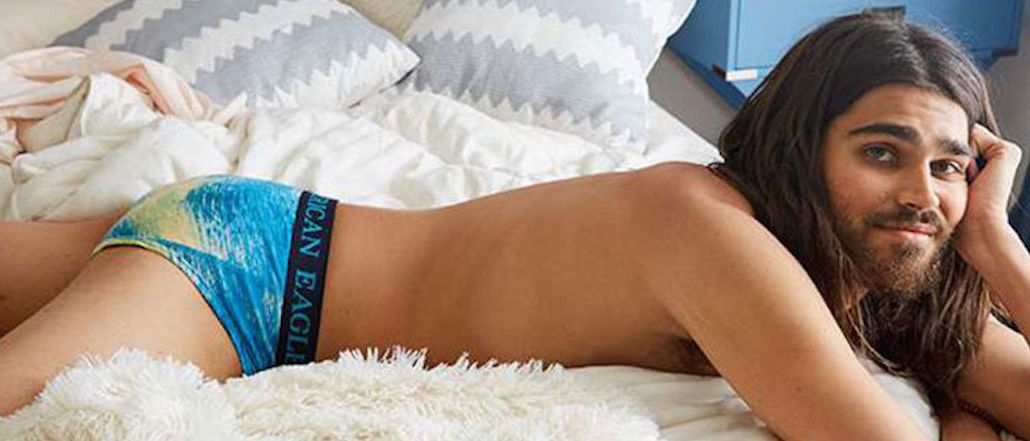Join us Dec. 1-3 in New Orleans for the Digiday Programmatic Marketing Summit
Make way, Fabio: The body-positivity movement is slowly changing male models

This is a story from Glossy, Digiday Media’s new publication devoted to how technology is changing the fashion and luxury industries.
When Kelvin Davis first started his body-positivity blog, Notoriously Dapper, in 2013, he had no idea that in just a few years he would be featured in a provocative ad campaign for American Eagle Outfitters, wearing only his underwear.
Davis was one of four models featured in the #AerieMAN campaign, an April Fool’s prank that offended some fans of the brand: It purported to be a campaign that supported body-positive portrayals of men. But ultimately it was just a stunt. (Get it? Chubby guys as models? Hilarious!) Davis claims the prank wasn’t meant to upset, but was a riff on the fact that Aerie is a traditionally female brand. He suggested more body positivity to come — and denied backpedaling on behalf of the brand, which he says is dedicated to male body positivity.
Regardless, Davis is at the forefront of outspoken plus-sized men making themselves known in a space that the fashion industry has so far neglected. The plus-sized market is estimated to be $17.5 billion, yet hardly any major clothing brands make plus-size menswear, with the exception of Ralph Lauren and Banana Republic, which have “extended sizes.” Even these offerings are poorly advertised, though, Davis said. “The more voices that are heard, the more brands will respond,” he said.
Raising awareness and visibility has been a major focus for Davis and his peers, including friends like Zach Miko, the first male model signed to IMG Models’ new plus-sized men’s division, Brawn. The department is the male counterpart to Curve, its 2-year-old division for plus-sized women.
Miko’s big break came in September 2015 while modeling for Target’s Mossimo line. He has since appeared in campaigns for U.K.-based brands including Blue Rhino.
“Inclusivity is something that’s at the core of Target and really guides all of our decisions,” said Jessica Carlson, communications director at Target. “We take that into account with all of our marketing tactics.”
Miko — 6 feet, 6 inches, with a 40-inch waist — has been making the rounds lately. The New York Times profiled him last week, and he’s been featured in Vogue and People. He has more than 58,000 fans on Instagram.
Miko told The Guardian that Target’s status as one of the biggest global retailers helped. “I think it made a splash because Target is a big retailer,” he said. “But they just put me in the shoot with classically sized male models, so all the fashion blogs were like, ‘Did Target sneak a plus size guy into their site?'”
Among these fashion blogs was Chubstr, operated by Bruce Sturgell, one of the first sites to write about Miko’s appearance on Target.com, which was subsequently picked up by a number of outlets.
“I think that if you want to affect change, you have to show the industry that there is money to be made in this space, and that there’s a lot of good will,” Sturgell said. “From a brand perspective, not only is featuring size diversity, different types of models and great fitting clothing important, but knowing that people will buy it and they want it and have the disposable income to buy this.”

Sturgell started his blog in 2011 after becoming exasperated by his shopping options in his former home in Missouri. So he did what every disgruntled tech-savvy person does — he complained online. He quickly found he wasn’t alone.
“It’s the classic thing with big and tall shops — the people that you’re seeing as models, they’re my dad’s age or ex-football players,” he said. “I’m short and wide. I want to see someone that looks awesome wearing these clothes in my size. Seeing that is aspirational.”
Davis echoed Sturgell, noting he wanted his blog to serve as an outlet for men to talk about body issues in a way that didn’t feel shameful, particularly in a society that discourages men to share sensitivities and insecurities. He said he only anticipates the number of plus-sized advocates to grow.
“Brands are eventually going to have to give in,” Davis said. “Because we’re not going anywhere.”
More in Marketing

The chance to win the holiday marketing season has already come and gone, per Traackr’s holiday report
The influencer marketing platform tracked the top brands according to VIT, Traackr’s proprietary metric for visibility, impact and trust.

The EU’s Digital Omnibus offers relief for ad tech, but hands more power to Big Tech and AI agents
What it means for GDPR, ad tech and the online media industry as a whole.

Future of Marketing Briefing: Bold call – the legacy influencer agency doesn’t fit the new market
The influencer shops that once drew investor enthusiasm are now ceding ground to tools that promise scale, predictability and a cleaner margin story.








